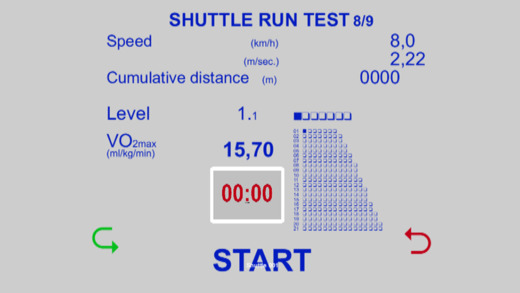The 20-m Shuttle run test is one oft he most commonly performed endurance fitness test and is also known as Bleep Test, Beep Test, Yo-Yo-Test, Yo-Yo-Endurance-Test, Multi stage 20-m Test, MFST/MST, Pacer Test, Léger -Test, Aero Test. In different countries the test is named as follows:Test de Léger (France), Mekik Testi (Turkey),Test Course-Navette (Spain),Kestävyyssukkulajuoksu (Finnland), 20メートルシャトルラン (Japan),Biptest (Norway), Челночный бег (Russia). The Shuttle Run determines a persons maximum aerobic endurance and it is to predict VO2max. It is so popular because it is simple to conduct, requires minimal and inexpensive equipment, and large groups can be tested in same time. The Shuttle Run Test is not only for athlets This test ist not just developed for athletes. A lot of organisations, like police, military, fire fighters and emergency services are using this test, in order to establish a great fitness level among their workers. Organization and Rules: The multistage 20-m test involves running continuously between two points that are 20 m apart. These shuttle runs are synchronized with beeps. The progression from one level to the next is signaled after 1 minute by 2 rapid beeps. The athlet runs on this distance from a cap to the other cap. He should be at the end of the 20-m course at every acustic signal. If the athlet is later than acustic signal more than 1ce in the 2-m box he is out. At this point he can already see his results History and Variations: There are many variations of the test commonly called the beep test. The standard 20 m test was first published by Léger and Lambert (1982). The original article described a protocol of two minute stages or levels, which was reduced to one minute stages when presented in an article two years later (Léger et al. 1984). Since the original paper describing the beep test by Léger and Lambert in 1982, there have been a few variations of the test published. Most of the test are very similar, though the names used to describe it may sound like they are very different tests. Differences Around the World: Variation 8,0 to 8,5 km/h: Out of Ireland came the Queen’s University of Belfast protocol (Riddoch, 1990) , which is a hybrid of the two protocols above, starting at 8.0 km/hour and increasing by 0.5 km/hour for each one minute stage.Variation 8,0 to 9,0 km/h. A version has been published by the British National Coaching Foundation, which is a variant on that originally described by Léger et al. (1984). Participants start at a speed of 8.0 km/hour, with the second stage at 9.0 km/hour, and thereafter there is an increase in speed by 0.5 km/hour each stage.
免費玩Multi Stage Shuttle Run Tests APP玩免費
免費玩Multi Stage Shuttle Run Tests App
| 熱門國家 | 系統支援 | 版本 | 費用 | APP評分 | 上架日期 | 更新日期 |
|---|---|---|---|---|---|---|
| 未知 | iOS App Store | 1.0 App下載 | $5.99 | 2014-08-11 | 2015-06-03 |




